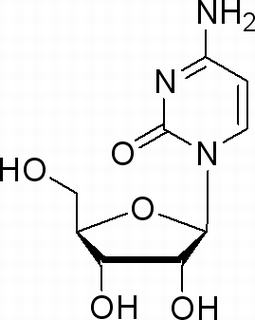Home
Products
Cytidine



| Product Name | Cytidine |
| Price: | $15 / 20mg |
| Catalog No.: | CN01034 |
| CAS No.: | 65-46-3 |
| Molecular Formula: | C9H13N3O5 |
| Molecular Weight: | 243.2 g/mol |
| Purity: | >=98% |
| Type of Compound: | Alkaloids |
| Physical Desc.: | Powder |
| Source: | The peels of Punica granatum L. |
| Solvent: | Chloroform, Dichloromethane, Ethyl Acetate, DMSO, Acetone, etc. |
| SMILES: | OC[C@H]1O[C@H]([C@@H]([C@@H]1O)O)n1ccc(nc1=O)N |
| Contact us | |
|---|---|
| First Name: | |
| Last Name: | |
| E-mail: | |
| Question: | |
| Description | Cytidine is a nucleoside molecule that is formed when cytosine is attached to a ribose ring, cytidine is a component of RNA.Target: Nucleoside antimetabolite/analogCytidine is a nucleoside molecule that is formed when cytosine is attached to a ribose ring (also known as a ribofuranose) via a β-N1-glycosidic bond. Cytidine is a component of RNA. If cytosine is attached to a deoxyribose ring, it is known as a deoxycytidine. Dietary sources of cytidine include foods with high RNA (ribonucleic acid) content, such as organ meats, Brewer's yeast, as well as pyrimidine-rich foods such as beer. During digestion, RNA-rich foods are broken-down into ribosyl pyrimidines (cytidine and uridine), which are absorbed intact. In humans, dietary cytidine is converted into uridine, which is probably the compound behind cytidine's metabolic effects.There are a variety of cytidine analogs with potentially useful pharmacology. For example, KP-1461 is an anti-HIV agent that works as a viral mutagen, and zebularine exists in E. coli and is being examined for chemotherapy. Low doses of azacitidine and its analog decitabine have shown results against cancer through epigenetic demethylation. |
| Target | Human Endogenous Metabolite |
| Density | 1.9±0.1 g/cm3 |
| Boiling Point | 529.7±60.0 °C at 760 mmHg |
| Flash Point | 274.1±32.9 °C |
| Exact Mass | 243.085526 |
| PSA | 130.83000 |
| LogP | -1.78 |
| Vapour Pressure | 0.0±3.2 mmHg at 25°C |